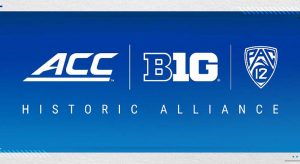Amidst Conference realignment, Big 12 Schools could be left out in the cold. A complete guide to potential Big 12 Conference Realignment


It seems that Big 12 commissioner Bob Bowlby’s talks with the Pac 12 about a possible merger/scheduling alliance did not go as well as expected. This is because yesterday the Pac 12, Big 10, ACC announced in a press conference, a super alliance to counter the already football dominant SEC that just added 2 of college sport’s biggest names in Texas and Oklahoma.
In their own words the purpose of the new alliance is a “scheduling component for football and women’s and men’s basketball designed to create new inter-conference games, enhance opportunities for student-athletes and optimize the college athletics experience for both student-athletes and fans across the country.” So we know that this alliance will create interconference scheduling between it’s members, and use it’s large power and influence to vote in and lobby to the NCAA in ways that will protect the interests of the 3 conferences.
This is solemn news for any Big 12 schools hoping to hop in the lifeboats of other power 5 conferences amidst the sinking ship of the Big 12. Before this development some if not all the remaining Big 12 schools would have stood a good chance of landing in another power 5 conference after a potential Big 12 implosion in 2025.https://www.westernkansasnews.com/2021/08/not-so-fast-big-12-implosion-unlikely-to-happen-before-2025/ But with an alliance of the Pac 12, Big 10, and ACC, the idea that this new super alliance would be looking for new members to fill its ranks seems unlikely at best.
However, with 3 of the Power 5 conferences teaming up, the SEC may be considering adding to its treasure trove of former Big 12 schools. College Football insider Greg Swaim says that the SEC will expand again to keep up with the other 3 power 5 conferences. The SEC would target TCU, Baylor, and Texas Tech to lock down the state of Texas, Oklahoma State would also be heavily considered. The SEC would also target ACC powerhouses Florida State and Clemson. But this scenario would be unlikely due to the length of the ACC media deal.
This is great news for the southern remaining Big12 schools, but those up north could be in the perilous state of losing Power 5 status. If all of this came to fruition the best-case scenario for the remaining 4 northern Big 12 schools would be for the SEC to send invitations to all the northern Big 12 schools after being spurned by Clemson and Florida State. Or for the new Pac 12, Big 10, ACC super conference to extend invitations to the remaining Big 12 members as a reaction to the SEC poaching of southern Big 12 schools.
If the Big 12 indeed fails to find a power 5 home for its remaining 4 members in this hypothetical scenario, then perhaps another strategy is in order. The remaining Big 12 schools could look west and add Colorado State, BYU, Boise State, and perhaps Airforce or UNLV. The New Big 12 could then ally with the American Athletic Conference which is the best non-power 5 conference in the country. Or the remaining Big 12 members could ally with the entire Mountain West and American Athletic Conference, they could even add Army and Navy who have had strong football programs recently. This could lead to some exciting matchups, especially in basketball where we could see Wichita State, Kansas, and Kansas State play each other every year.
While this option would leave the Big 12 as a clear step down in prestige from the other remaining power 5 conferences, it would also be a clear step up from the remaining non-power 5 conference. The alliance would undoubtedly be strong enough to secure an automatic bid in an expanded 12 team college football team playoff, leaving some of the remaining Big 12 school’s dignity and prestige intact.
But the SEC deciding to expand further is no guarantee. If it doesn’t, the remaining 8 Big 12 members would likely be forced to stick together. If they did 4 options stand out as their best courses of action. Option 1 is to stay at 8 and hope splitting the revenue between fewer members would make up for the loss of Oklahoma and Texas and the prestige that they brought with them. This option would be much more appealing if the other power 5 conferences were not planning on continued expansion. If the Big 12 stuck to this option, then they would stick out like a sore thumb, much like it did when the Big 12 decided not to have a conference title game. A decision that may have cost them several College Football Playoff berths.
Option 2 would be to poach members from other conferences and expand to 12 or 16 teams. This option would see the Big 12 adding the best of the rest to their conference, which mostly means poaching the top schools of the American Athletic Conference, and the Mountain West. A newly restocked Big 12 could have new members such as Cincinnati, Houston, Memphis, Central Florida, BYU, and perhaps Boise State or Colorado State. An expanded Big 12 would allow the Big 12 to restock without taking on the fat of the nonpower 5 conferences. The only cons to this plan would be that an 8 team Big 12 may not be an attractive enough option to poach schools from the American. It could also lead to the American in turn poaching schools from the Big 12. Also merely expanding to 12 or 16 teams may not be enough to capture the attention of cable networks in an era of far larger super conferences.
This leaves us with option 3 which is a Big 12 and AAC team-up. Without further moves being made the Big 12 and AAC stand out as a big step up from the non-power five conferences but a step down from the non-Big 12 power five conferences. So why not team up? This alliance would stock the Big 12 with more members, many of whom were members of prestigious conferences before the last few rounds of conference realignment took place. The AAC boasts former Big East members like Cincinnati, Temple, and South Florida, and former Southwestern Football conference members (the former home of Texas and Oklahoma) SMU and Houston. A team-up like this could secure a hefty media rights deal and an automatic bid into an expanded College Football playoff. Furthermore, the prestige of the AAC schools would be raised making a future media deal more profitable down the road.
All that is left is my personal favorite option 4. Option 4 isn’t all that different from option 3 except in the sense that it would be the Big 12, and AAC teaming up with each other and with the Mountain West and Army/Navy getting thrown into the mix. This new combination would give the new Big 12 an empire that stretches from Florida to California. It would also add large TV markets like San Diego, Las Vegas, Salt Lake City, Cincinnati, Orlando, Houston, Philadelphia, and Memphis. While a Big 12, AAC team-up is intriguing, it might not be enough to catch the attention of the TV networks. Adding the large TV markets of the Mountain West could be just enough to get the new alliance the deal it wants. Furthermore, it would unite every military academy with major sports programs under 1 roof. With Army, Navy, and Airforce all in tow, this alliance would be the official conferences of the United States military.
So, while the Big 12 seems to be the odd man out when it comes to conference realignment. The remaining schools still have some solid options to maintain their relevancy within Collegiate Athletics.









